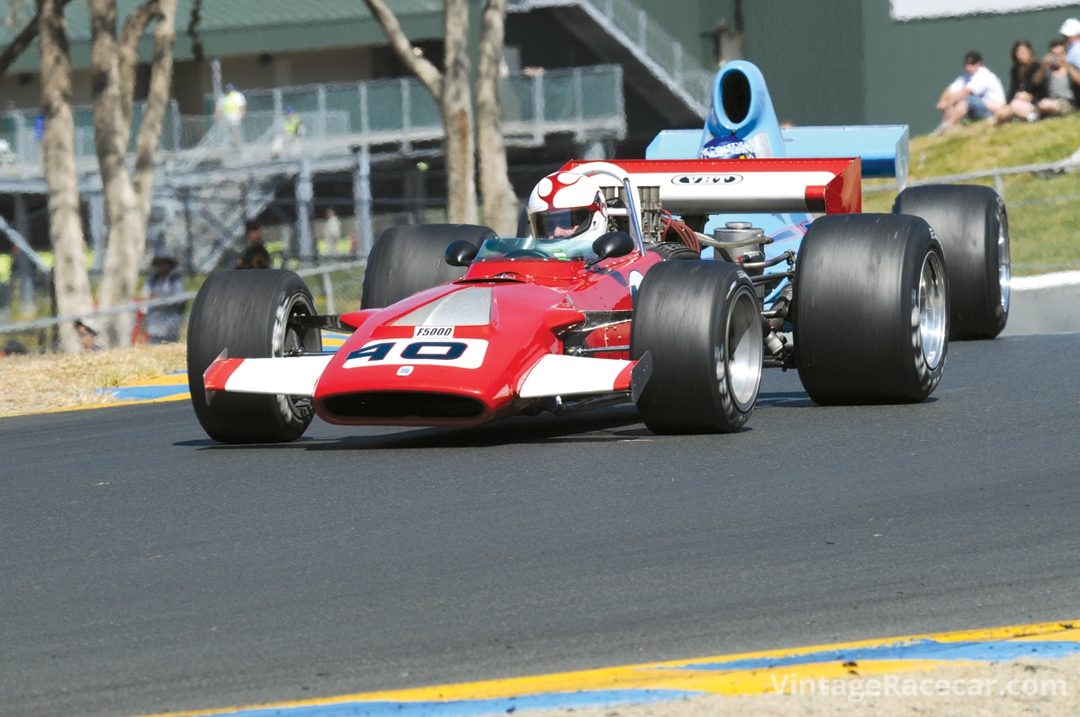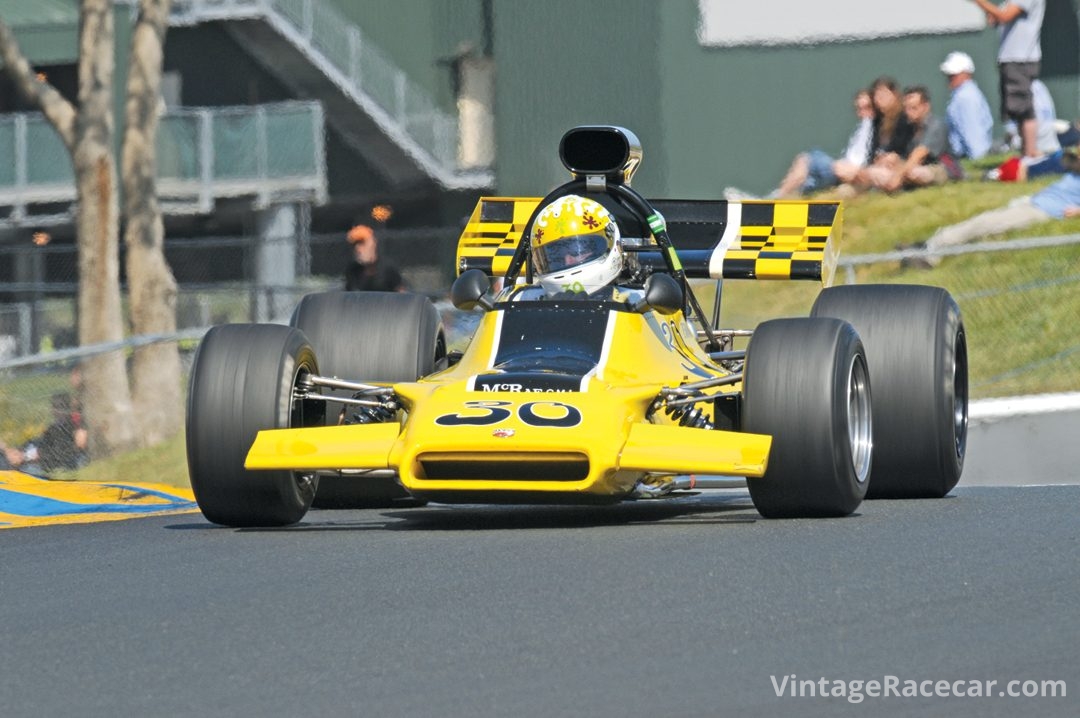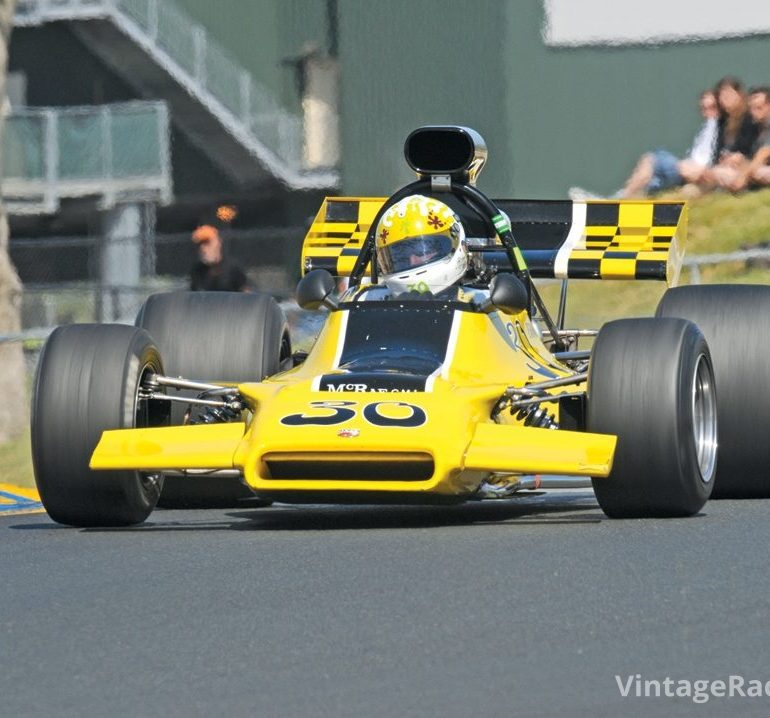Formula 5000 was a racing series for open-wheel, single-seater racing cars built to a specific set of rules. The engine of choice became the venerable small block Chevrolet V-8 of 5-liter displacement. It started as a bright idea in 1967 and ran successfully until politics between the governing body, race organizers, and team owners did it in at the end of the 1976 season.
Although there were four competitive Formula 5000 championships, the Rothmans series in Europe, the Tasman series in Australia and New Zealand, and the Tarmac series in Britain, the heart and soul of Formula 5000 was the North American series. In the early 1970s it was known as the L&M Championship after title sponsor L&M Tobacco. For 1974, the SCCA and rival governing body USAC merged to run Formula 5000. A variety of chassis manufacturers took part, but the car that dominated the later years of the series was the Lola T332. Even though the rules allowed the turbocharged Offenhauser engine to run, the engine that dominated the series was the Chevy V-8 that could put out a reliable 550 bhp and 425 lbs-ft of torque at 8,000 rpm. In fact, Chevrolets won all but five races in series history. George Follmer took two with a Ford-powered Lotus 70, Gus Hutchinson won twice in a Cosworth DFV-powered Brabham BT26 and Jackie Oliver scored once with a Dodge V-8-powered Shadow DN6.
Even though many other top drivers, including Mario Andretti, Mark Donohue, David Hobbs, James Hunt, Alan Jones, Jody Scheckter, and Al Unser took part, the dominant driver one associates with Formula 5000 is Brian Redman, who won the championship in 1974, 1975, and 1976.
Today, F5000 cars represent a lot of racing performance for one’s money. One of the most important factors in determining current market value is the cost and quality of the restoration. It is also important to note that currently, in New Zealand, Australia, and Great Britain, F5000 cars enjoy a greater following than in America, and therefore command a greater value. This, combined with currency rates, import duties, and VAT, can create a 25-35 percent premium in the estimated value of the vehicle in these countries.
| Make | Model | Acceptance | Level III | Level II | Level I |
| Begg | FM2,FM4,FM5 | 3 | $80,000 | $90,000 | $100,000 |
| Caldwell | D8 | 3 | $60,000 | $70,000 | $80,000 |
| Chevron | B24 | 3 | $100,000 | $110,000 | $120,000 |
| B28 | 3 | $90,000 | $100,000 | $115,000 | |
| B37 | 3 | $90,000 | $100,000 | $115,000 | |
| Cooper | T90 | 3 | $70,000 | $80,000 | $100,000 |
| Crossle | 15F | 3 | $70,000 | $80,000 | $95,000 |
| Eagle | 1968 | 3 | $80,000 | $90,000 | $100,000 |
| A73 | 3 | $90,000 | $100,000 | $120,000 | |
| 755 | 3 | $100,000 | $120,000 | $135,000 | |
| Elfin | MR5, 6, 8, 9 | 3 | $90,000 | $110,000 | $120,000 |
| LeGrand | Mk7 | 3 | $60,000 | $70,000 | $75,000 |
| Leda | LT20, 22, 25 | 3 | $80,000 | $95,000 | $105,000 |
| Lola | T140-142 | 3 | $55,000 | $65,000 | $80,000 |
| T190 | 3 | $60,000 | $70,000 | $85,000 | |
| T191, 192 | 3 | $65,000 | $75,000 | $70,000 | |
| T300 | 3 | $75,000 | $85,000 | $100,000 | |
| T330, 332 | 3 | $90,000 | $105,000 | $120,000 | |
| T400 | 3 | $90,000 | $105,000 | $120,000 | |
| Lotus | 70 | 3 | $90,000 | $105,000 | $120,000 |
| McKee | Mk8 | 3 | $75,000 | $85,000 | $100,000 |
| Mk12, 18 | 3 | $75,000 | $85,000 | $100,000 | |
| McLaren | M10A, B | 3 | $90,000 | $110,000 | $120,000 |
| M18 | 3 | $90,000 | $105,000 | $120,000 | |
| M22 | 3 | $90,000 | $105,000 | $120,000 | |
| McRae | GM1 | 3 | $90,000 | $105,000 | $115,000 |
| March | 73A | 3 | $80,000 | $90,000 | $105,000 |
| 74A, 75A, 76A | 3 | $85,000 | $100,000 | $115,000 | |
| Shadow | DN6 | 3 | $85,000 | $100,000 | $115,000 |
| Surtees | TS5, TS8 | 3 | $75,000 | $85,000 | $105,000 |
| TS11 | 3 | $80,000 | $90,000 | $110,000 | |
| Spectre | HR-1 | 3 | $65,000 | $75,000 | $90,000 |
| Talon | MR1 | 3 | $70,000 | $80,000 | $95,000 |
| Trojan | T101 | 3 | $70,000 | $80,000 | $90,000 |
| T102 | 3 | $75,000 | $85,000 | $100,000 |
1970 Leda LT20/22/25

By 1970 Len Terry was one of the top single-seat racecar designers. To his credit were the race winning BRM P261, the Lotus 38 Indy car, the beautiful Gurney Eagle Formula One and Indy cars, the Surtees TS5 F5000 and various Mirage sports cars. John Surtees had commissioned Terry to design the LT17 or TS5, which was one of the most successful F5000 cars of 1969. Terry decided to build his own Formula 5000 car for 1970, the Leda LT20. Surprisingly, his LT20 was not much of a success. It was followed by the improved LT22 and then the LT25. This brought the Leda closer to the front of the grid. The last evolution of the Len Terry design was renamed the McRae GM-1. One of these cars was driven by a young Steve Matchett, now a Speed Channel F1 commentator, in Los Angeles. Phil Henry also drove a Leda.
1972 McRae GM-1

Graham McRae and Len Terry combined talents to develop the Leda LT25 into the LT27 and ultimately the McRae GM-1 for F5000. This car, with the talented McRae behind the wheel was the dominant machine during the 1972 season. It was well-engineered and immediately successful. McRae won the Tasman Championship in New Zealand in 1972 and the U.S. Championship as well. He even won races in Europe, where he finished 3rd in the championship. McRae built 14 F5000 cars that year. They were driven by such names as Trevor Taylor, Brett Lunger, and Vern Schuppan. The combination of Len Terry and Graham McRae made this car the dominant car for the 1972 season, winning nearly half the races entered. A wonderful story of a great designer working with a great driver to produce winning results.
Criteria Used For Assessing Valuations for this Guide:
- Degree of Originality
- Overall Condition, Restoration
- Technology, Design, Coachbuilder
- Production Numbers/Rarity
- Competition History
- Ownership History, Documentation
- Modern Event Eligibility
Regional Variances
The prices stated in this guide are based on U.S. values. The values of historic racing cars can vary as much as 25%-35% in other countries, depending on local market appeal, currency rates, import duties, and VAT. Most of the time, we are able to document known sales or closed escrows, as they say in real estate. When this is not possible, a logical estimate of the car’s value is given, based on its sales history and relationship to cars of its type.
The prices stated in this guide are based on U.S. values. The values of historic racing cars can vary as much as 25%-35% in other countries, depending on local market appeal, currency rates, import duties, and VAT.
LEVEL |
VALUATION CATEGORIES |
|---|---|
I |
The best combination of all criteria. |
II |
Satisfies mid-range of criteria. |
III |
In need of restoration. Meets only a few points of criteria |




